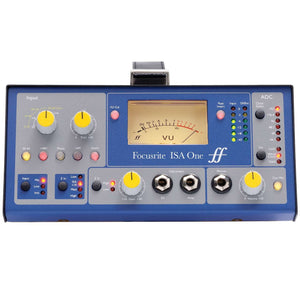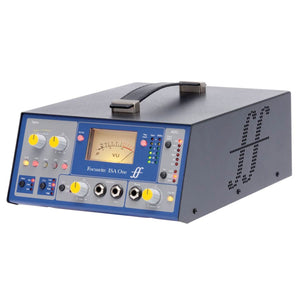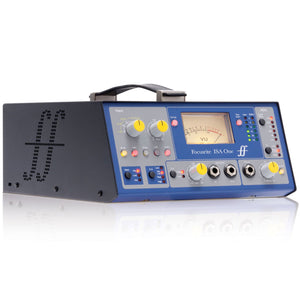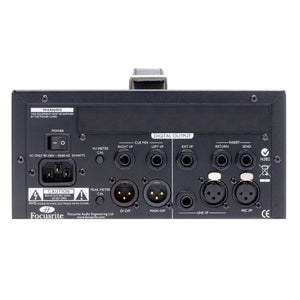Your Cart is Empty




$999.00
MOIFONEAB-AU
Focusrite ISA ONE Single Channel Classic ISA Mic Preamp/DI
The ISA ONE provides a world-class Focusrite microphone pre-amp with the convenience of an independent DI in a travel-friendly solution. Featuring a rugged, portable all-metal enclosure, the ISA One combines the classic Focusrite microphone preamp with a flexible, independent DI channel and optional 192kHz precision A/D conversion.
Type: Preamps/Channel Strips
-
-
Focusrite ISA ONE PRODUCT FEATURES:
The Focusrite Heritage Sound - in a versatile, transportable package
Back in the mid-1980s, Sir George Martin commissioned console design legend Rupert Neve to build a series of new, ‘no compromise’ console modules for AIR studios. They were an enormous hit and formed the basis of the Focusrite Studio Console, widely regarded as the best-sounding analogue recording console of all time. Today, the descendants of those modules are used in leading studios around the world, and their sought-after Focusrite Heritage Sound lies behind thousands of hit records. Today’s ISA Range from Focusrite puts the classic sound of Focusrite into your own studio or live performance.
Classic Focusrite transformer-based mic preamplifier
At the heart of the ISA range is the microphone preamplifier with its Lundahl input transformer – essentially the same circuit, based on the original ISA110, that has been used for 30 years in successive Focusrite designs. The input transformer imparts a special character to the sound that can’t be truly emulated in any other way: inseparable from the microphone itself, the transformer input stage is ideal for use with classic microphones. But this mic pre has a twist the original didn’t have, which makes it far more versatile: four carefully-selected impedances allow you to match microphone to input in different ways. Bring out the character of a classic mic or emphasise a special feature, or go for a totally transparent, modern sound – it’s up to you.
Independent direct input
Whether you’re an artist, engineer or producer, you’ll appreciate the versatility of the ISA One, with its front-panel DI input. The DI includes low/high impedance switching and an amplifier output, and its own feed to the optional A/D converter and separate rear-panel XLR output
-
Focusrite ISA ONE TECHNICAL SPECIFICATIONS:
Analogue Channel Inputs
- XLR Mic input
- One XLR and one TRS line input
- XLR Instrument input TRS Jack
- External ADC input TRS Jack
- TRS jack return
Analogue Channel Outputs
- TRS jack send
- XLR balanced line output
- XLR DI output
- TS jack DI through
Analogue Channel Additional I/O
- TRS Jack cue mix left input
- TRS Jack cue mix right input
- 1/4” TRS Jack headphones output
Mic Input Response
Gain range
0dB to 60dB in 10dB steps + 20 dB of variable gain
Input Impedance
Switched Impedance setting Equivalent Input Impedance at 1kHz
Low = 600 Ohms
ISA110 = 1400 Ohms
Med = 2400 Ohms
High = 6800 OhmsEIN (Equivalent Input Noise)
-126dB measured at 60dB of gain with 150 Ohm terminating impedance and 22Hz/22kHz band-pass filter
Noise
Noise at output with unity gain (0 dB) and 22 Hz-22 kHz band pass filter
-97 dBu
Signal-to-Noise Ratio
106 dB relative to max headroom (9dBu)
Total Harmonic Distortion + Noise
Measured at medium gain (30dB) with a 1kHz -20dBu input signal and with a 22Hz/22kHz band-pass filter
< 0.0009%
Frequency Response
At minimum gain (0 dB)
-0.5dB down at 10Hz and -3dB down at 125kHz
At maximum gain (60dB)
-3dB down at 16Hz and -3dB down 118kHz
CMRR (Common Mode Rejection Ratio)
98dB (Channel 1, 1kHz, maximum gain with +24 dBu input)
Crosstalk Channel to Channel
With 10dB@1kHz input to chA, chB output =104dBrA. With 10dB@10kHz input to chA, chB output = 84dBrA
Line Input Response
Gain range
-20dB to +10dB in 10dB steps + 20 dB of variable gain
Input Impedance
10 kΩ from 10 Hz to 200 kHz
Noise
Noise at main output with gain at unity (0 dB) measured with 50 Ω source impedance and a 22Hz - 22 kHz band pass filter
-96 dBu
Signal-to-Noise Ratio
Measured with a 22 Hz-22 kHz band pass filter
120 dB relative to max headroom (24 dBu)
118dB relative to 0dBFS (+22dBu)Total Harmonic Distortion + Noise
Measured with a 0 dBu input signal, and a 22 Hz-22 kHz band pass filter
0.0001%
Frequency Response
At unity gain (0 dB)
-0.3dB down at 10Hz and -3dB down at 200kHz
Instrument Input Response
Gain range
10dB to 40dB continuously variable
Input Impedance
High = greater than 1M
Low =greater than 300kNoise
Measured with 22 Hz-22 kHz band pass filter
Minimum gain (+10 dB): -92 dBu
Maximum gain (+40dB): -62dBuTHD
At minimum gain (+10)
Frequency Response
At minimum gain (+10 dB)
-10dB input: 10Hz-100kHz +/- 0.6dB
At maximum gain (+40 dB)
-40dB input: -2.5dB down at 10Hz and 0dB at 100kHz
Meters
Moving Coil (MC) Meter
factory calibrated to 0VU = +4dBu with 1kHz sinewave. With the VU Cal button pressed the meter can be adjusted on the rear panel to allow 0VU to equal +10dBu to +26dBu with the centre detent being equal to +22dBu.
Peak LED Meters
Calibrated in the detent position for 0dBFS = +22dBu, calibration is adjustable on the rear panel to allow 0dBFS to equal +10dBu to +26dBu
Routing for MC and Peak1 meter is after the HPF, pre insert send or switched post insert return. Peak2 is always pre ADC channel 2, which can be fed by external input or Instrument input.
LED Levels
As follows, when peak calibration is set to center detent on the rear panel. (This is when using the internal ADC).
0 = +22dBu
-2 = +20dBu
-6 = +16dBu
-12 = +10dBu
-18 = +4dBu
-42 = -20dBuFrequency Response
At minimum gain (+10 dB)
-10dB input: 10Hz-100kHz +/- 0.6dB
At maximum gain (+40 dB)
-40dB input: -2.5dB down at 10Hz and 0dB at 100kHz
High-Pass Filter
Roll-Off
18 dB per octave (3 pole filter)
Frequency
Fixed 75Hz measured at the 3dB down point
Weight and Dimensions
W x D x H
220mm (W) x 104mm (H) x 254 - 290mm (D - top to bottom)
8.66" (W) x 4.1" (H) x 10" - 11.4" (D - top to bottom)
Weight
3.9 kg
8.6 lbs




